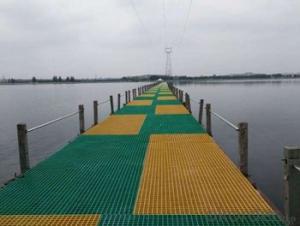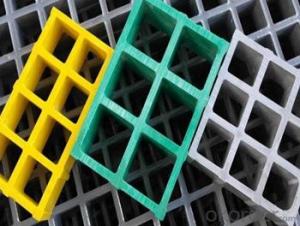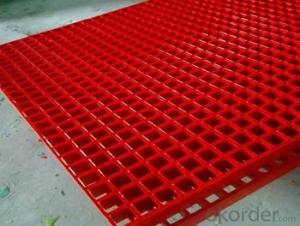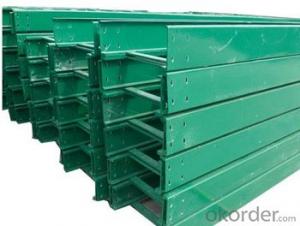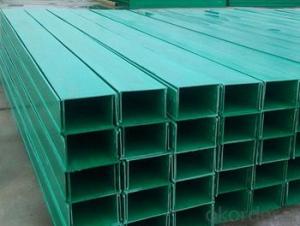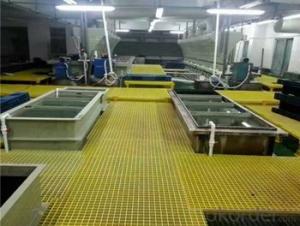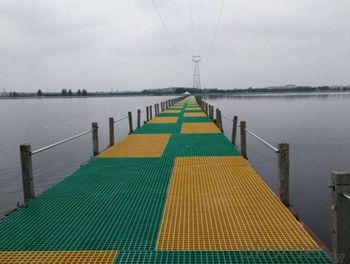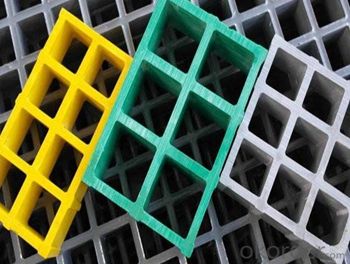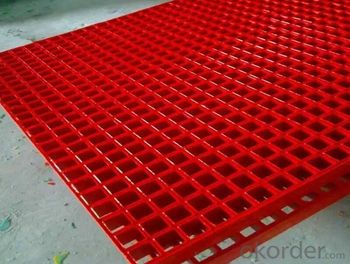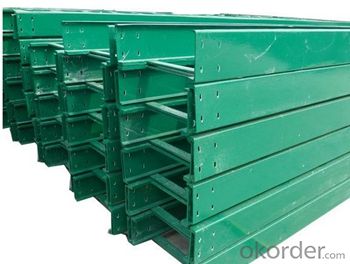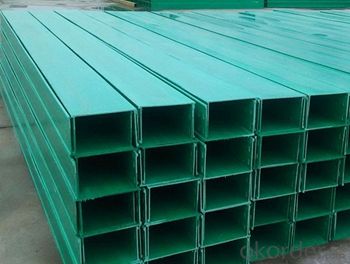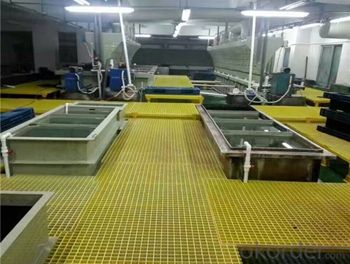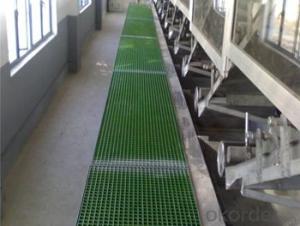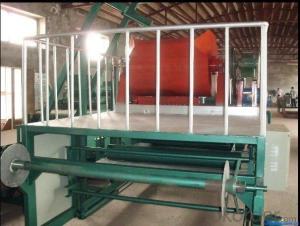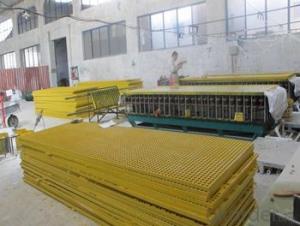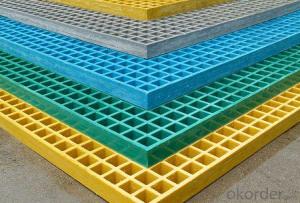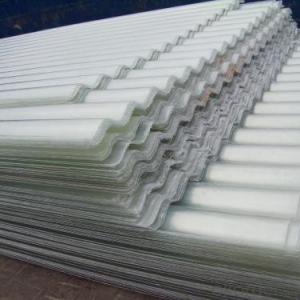FRP Pultrusion Profiles - Anti-Corrosion, Non-Rusty, Toxic-Free FRP Pultruded Grating Made in China
- Loading Port:
- Tianjin
- Payment Terms:
- TT OR LC
- Min Order Qty:
- 18 watt
- Supply Capability:
- 30000 watt/month
OKorder Service Pledge
OKorder Financial Service
You Might Also Like
Specification
PRODUCT DESCRIPTION
Pultruded grating is made by a particular assembly process, which using “I” shape as its main load-bearing and special rod to go through the bearing bar. Pultruded grating include the standard grating and the custom grating, the custom grating can be designed to meet customer’s requirement or special using condition by changing the shape, size and space of the bearing bars, the surface can be covered with lozenge panel, grit panel, or added the anti-slippery sand directly.
SPECIFICATION
The standard space between two crossbars is 6 inch or 12 inch.
Thickness (mm) | Bar width (mm) | Open space (mm) | Open rate (%) | Approx weight (kg/m |
25.4 | 15.2 | 22.8 | 60 | 13.2 |
25.4 | 15.2 | 15.2 | 50 | 15.9 |
25.4 | 15.2 | 10.1 | 40 | 18.5 |
25.4 | 40 | 10.8 | 21 | 14.5 |
38.1 | 15.2 | 22.8 | 60 | 15.8 |
38.1 | 15.2 | 15.2 | 50 | 19.1 |
38.1 | 15.2 | 10.1 | 40 | 22.4 |
50.8 | 25.4 | 25.4 | 50 | 16.6 |
50.8 | 25.4 | 12.7 | 33 | 21.1 |
FEATURES
a. Anti-corrosion and anti-rust
b. Light weight and high strength
c. Anti-flammable
d. Anti- fatigue
e. Safe and anti-slippery
f. Anti-ageing
g. Easy of maintenance
h. Excellent electromagnetism property
i. Good economic benefit
APPLICATION
Operation terrace,
stair walkway,
ground floor,
trench cover,
sidewalk,
foot bridge,
equipment safety fence,
scaffold.
COMPANT DESCRIPTION
CNBM,China National Building Materials Group is a state-owned enterprise in charge of administrative affairs in china building materials industry. Established in 1984, CNBM is a large group corporation of building materials with total assets of 25 billion RMB and a total staff of 30,000.CNBM now owns 200 subordinating firms of solely owned and joint-venture companies.
FAQ
1.Q:Are you factory or trading company ?
A:We are Factory produce FRP machines and FRP products.
2.Q:If can customized by customers requirements?
A:yes,we can produce the machine with customized size.
3.Q:How about the payment?
A:We accept any kind of payment.
4.Q:What is the guarantee?
A:Gurantee is one year.
PICTURES
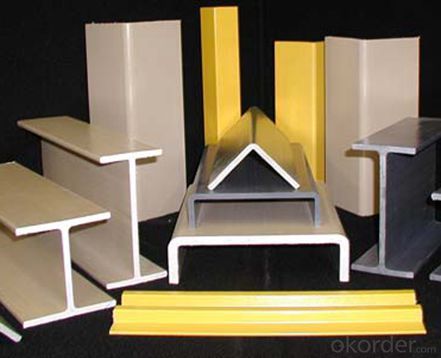
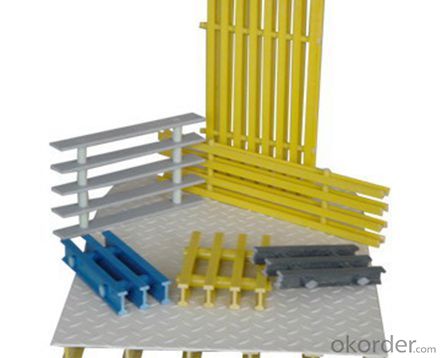
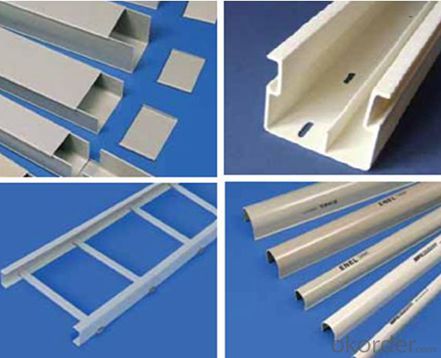
- Q: What is the lifespan of FRP pultrusion profiles?
- The lifespan of FRP (Fiber Reinforced Polymer) pultrusion profiles can vary depending on several factors. Generally, FRP pultrusion profiles have a long lifespan and are known for their durability and longevity. One key factor that influences the lifespan of FRP pultrusion profiles is the quality of the materials used in their construction. High-quality FRP materials, such as those made with premium resins and high-strength fibers, tend to have a longer lifespan compared to lower-quality materials. Additionally, the environmental conditions in which the FRP pultrusion profiles are installed can impact their lifespan. Exposure to extreme temperatures, moisture, UV radiation, chemicals, and mechanical stresses can all affect the performance and lifespan of FRP profiles. Therefore, proper installation and maintenance are crucial to ensuring their longevity. When properly designed, manufactured, and installed, FRP pultrusion profiles can have a lifespan ranging from 25 to 50 years or even longer. However, it is important to note that this estimate can vary depending on the specific application, the level of exposure to harsh conditions, and the overall care and maintenance of the profiles over time. Regular inspections, cleaning, and repairs, if necessary, can help extend the lifespan of FRP pultrusion profiles. Consultation with manufacturers or industry experts can provide more specific information on the expected lifespan of FRP profiles for a particular application or environment.
- Q: Can FRP pultrusion profiles be used in the construction of amusement park rides?
- Amusement park rides can utilize FRP pultrusion profiles due to their various advantages. Firstly, these profiles have a high strength-to-weight ratio, making them lighter than steel without compromising structural integrity. Consequently, the weight of the ride's structure can be reduced while maintaining safety. Secondly, FRP pultrusion profiles possess exceptional resistance to corrosion. Unlike steel, they do not rust or deteriorate when exposed to moisture or chemicals commonly found in amusement parks. This makes them ideal for rides constantly exposed to water, humidity, and harsh conditions. Moreover, these profiles offer design flexibility, allowing for customized shapes and sizes that meet specific requirements of amusement park rides. This versatility enables engineers and designers to create intricate and aesthetically pleasing structures. Furthermore, FRP pultrusion profiles provide excellent electrical insulation, ensuring a high level of safety for rides with electrical components and wiring. Additionally, these profiles are non-magnetic, which is advantageous for rides utilizing magnetic systems or sensors. Non-magnetic materials eliminate the risk of interference or disruption to the ride's functionality. Lastly, FRP pultrusion profiles are durable and require minimal maintenance. They are resistant to UV radiation, preventing degradation or fading due to prolonged sunlight exposure. This reduces the need for frequent painting or coating, resulting in lower maintenance costs over time. In conclusion, the combination of lightweight, corrosion resistance, design flexibility, electrical insulation, non-magnetic properties, and durability make FRP pultrusion profiles an excellent choice for constructing amusement park rides.
- Q: Can FRP pultrusion profiles be used in the construction of industrial flooring?
- Yes, FRP (Fiber Reinforced Polymer) pultrusion profiles can be used in the construction of industrial flooring. FRP pultrusion profiles are made from a composite material that consists of a combination of strong fibers, typically glass or carbon, and a polymer resin. This combination of materials provides exceptional strength, durability, and corrosion resistance, making FRP profiles highly suitable for industrial flooring applications. One of the main advantages of FRP pultrusion profiles is their high strength-to-weight ratio. This makes them lighter and easier to handle compared to traditional materials such as steel or concrete. Additionally, FRP profiles are non-conductive and non-magnetic, which can be beneficial in certain industrial environments. FRP pultrusion profiles are also highly resistant to various chemicals, moisture, and UV radiation, making them ideal for use in harsh and corrosive environments. They do not rust or corrode like steel and are not affected by moisture or rot like wood, ensuring long-lasting performance and minimal maintenance requirements. Furthermore, FRP profiles can be customized and manufactured in different shapes, sizes, and load-bearing capacities to meet specific industrial flooring requirements. They can be designed to withstand heavy loads, impact, vibration, and other dynamic forces commonly encountered in industrial settings. In summary, FRP pultrusion profiles offer numerous advantages that make them suitable for the construction of industrial flooring. Their high strength, durability, corrosion resistance, and customizable nature make them a reliable and cost-effective choice for industrial flooring applications.
- Q: Are FRP pultrusion profiles resistant to wear or abrasion?
- Yes, FRP pultrusion profiles are highly resistant to wear and abrasion. The combination of strong reinforcing fibers and a durable resin matrix makes them capable of withstanding harsh conditions and maintaining their structural integrity over time, even in high-stress environments. This resistance to wear and abrasion makes FRP pultrusion profiles an excellent choice for applications that require long-lasting and low-maintenance solutions.
- Q: Can FRP pultrusion profiles be used in architectural or decorative applications?
- Yes, FRP pultrusion profiles can definitely be used in architectural or decorative applications. FRP, which stands for Fiber Reinforced Polymer, is a composite material that combines strong fibers, such as glass or carbon, with a polymer resin matrix. This combination creates a lightweight, durable, and corrosion-resistant material that is ideal for various applications, including architecture and decoration. FRP pultrusion profiles can be manufactured in a wide range of shapes and sizes, making them highly versatile for architectural and decorative purposes. These profiles can be used to create aesthetically pleasing structures, such as columns, beams, and facades, that enhance the visual appeal of buildings. Additionally, FRP pultrusion profiles can be fabricated to mimic the appearance of other materials, such as wood or metal, allowing for the creation of decorative elements that blend seamlessly with the overall design. Furthermore, FRP pultrusion profiles offer several advantages over traditional materials commonly used in architecture and decoration. They are lightweight, which makes them easier to handle and install, reducing labor costs. They are also highly resistant to corrosion, weathering, and UV radiation, ensuring long-lasting performance in outdoor applications. Additionally, FRP profiles can be customized to meet specific design requirements, including color, texture, and surface finish, providing endless possibilities for creative expression. In summary, FRP pultrusion profiles are a viable option for architectural and decorative applications. Their lightweight, durable, and customizable nature makes them suitable for a wide range of design needs, while their corrosion resistance ensures longevity and low maintenance. Whether it's for structural support or decorative embellishments, FRP pultrusion profiles offer an excellent choice for enhancing the aesthetics and functionality of architectural and decorative projects.
- Q: Are FRP pultrusion profiles suitable for the manufacturing of chemical reactors?
- Yes, FRP pultrusion profiles are suitable for the manufacturing of chemical reactors. FRP (Fiber Reinforced Polymer) pultrusion profiles offer excellent resistance to corrosion, high strength-to-weight ratio, and dimensional stability, making them ideal for use in chemical reactors. Additionally, FRP materials can withstand a wide range of chemical environments and temperatures, making them a reliable choice for this application.
- Q: Do FRP pultrusion profiles require any special tools for installation?
- Installation of FRP pultrusion profiles necessitates the use of specialized tools. These profiles are manufactured through a continuous process wherein fibers are drawn through a resin bath and subsequently into a heated die, resulting in a material that is not only strong and lightweight but also resistant to corrosion. To ensure the proper installation of FRP pultrusion profiles, various specific tools are commonly employed. These tools encompass: 1. Cutting Tools: During installation, it may be necessary to cut FRP profiles to specific lengths. To achieve clean and precise cuts, specialized cutting tools like high-speed saws or abrasive wheels are frequently utilized. 2. Drilling Tools: For the insertion of fasteners or other fittings, it might be necessary to drill holes in FRP profiles. To prevent damage to the profile while creating these holes, special drill bits designed for working with composite materials are typically employed. 3. Fastening Tools: Depending on the application, it may be necessary to fasten FRP profiles to other surfaces or structures. Commonly used fasteners include stainless steel screws, bolts, or adhesives, which are specifically chosen for their ability to securely hold the profiles in place. 4. Joining Tools: In certain instances, it may be necessary to join FRP profiles together in order to create longer lengths or more intricate shapes. To ensure a robust and secure connection, special joining techniques such as bonding, riveting, or the use of mechanical connectors are employed. It should be noted that the specific tools required for installation may vary depending on factors such as the complexity and size of the project, as well as the recommendations provided by the manufacturer. Therefore, it is always advisable to consult the manufacturer's installation guidelines or seek professional assistance to ensure the proper installation and optimal performance of FRP pultrusion profiles.
- Q: Are FRP pultrusion profiles resistant to hydrochloric acid?
- FRP pultrusion profiles are generally resistant to hydrochloric acid. The corrosion resistance of FRP (Fiber Reinforced Polymer) materials varies depending on the specific resin and fiber used in the manufacturing process. However, most FRP pultrusion profiles are designed to withstand exposure to a wide range of chemicals, including hydrochloric acid. The corrosion resistance of FRP is attributed to the chemical inertness of the resin matrix, which is typically made of polyester, vinyl ester, or epoxy. These resins provide a protective barrier against chemical attack and allow FRP profiles to maintain their structural integrity even in harsh environments. That being said, the level of resistance can vary depending on the concentration and temperature of the hydrochloric acid. In highly concentrated or elevated temperature conditions, the resistance may be reduced. It is always advisable to consult the manufacturer's specifications or seek expert advice to ensure the suitability of FRP pultrusion profiles for specific acid concentration and temperature ranges. Overall, FRP pultrusion profiles are known for their excellent chemical resistance, and they are often chosen for applications where exposure to acids or corrosive environments is expected.
- Q: Can FRP pultrusion profiles be used in aerospace applications?
- Yes, FRP (Fiber Reinforced Plastic) pultrusion profiles can be used in aerospace applications. FRP materials have several advantages that make them suitable for aerospace use. Firstly, they have excellent strength-to-weight ratios, which is crucial in the aerospace industry to reduce weight and enhance fuel efficiency. Secondly, FRP materials exhibit high corrosion resistance, making them suitable for prolonged exposure to harsh environments, such as high altitude and extreme temperatures. Additionally, FRP pultrusion profiles offer design flexibility, allowing for complex shapes and geometries to be manufactured. This flexibility enables aerospace engineers to tailor the profiles to specific requirements and optimize performance. Furthermore, FRP materials have low thermal conductivity, which helps in insulation applications and reducing heat transfer. Lastly, FRP pultrusion profiles have demonstrated good fatigue resistance, which is essential for aerospace applications subjected to cyclic loading. Overall, these properties make FRP pultrusion profiles a viable choice for various aerospace components, including structural members, interior parts, and electrical enclosures.
- Q: Are FRP pultrusion profiles resistant to chemicals used in pharmaceutical packaging?
- Yes, FRP pultrusion profiles are highly resistant to chemicals used in pharmaceutical packaging. The unique properties of fiberglass reinforced plastic, such as its corrosion resistance and non-reactivity to most chemicals, make FRP pultrusion profiles an ideal choice for pharmaceutical packaging applications.
Send your message to us
FRP Pultrusion Profiles - Anti-Corrosion, Non-Rusty, Toxic-Free FRP Pultruded Grating Made in China
- Loading Port:
- Tianjin
- Payment Terms:
- TT OR LC
- Min Order Qty:
- 18 watt
- Supply Capability:
- 30000 watt/month
OKorder Service Pledge
OKorder Financial Service
Similar products
Hot products
Hot Searches
Related keywords
